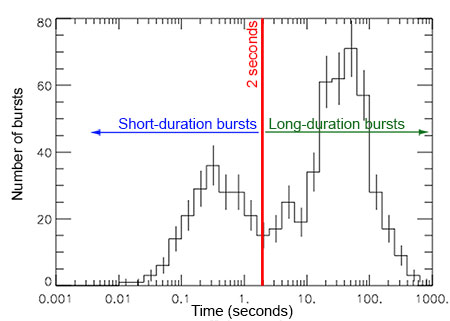Gamma-ray Bursts
Gamma-ray bursts (GRBs) are short-lived bursts of gamma-ray light, the most energetic form of light. Lasting anywhere from a few milliseconds to several minutes, GRBs shine hundreds of times brighter than a typical supernova and about a million trillion times as bright as the Sun. When a GRB erupts, it is briefly the brightest source of cosmic gamma-ray photons in the observable Universe.
Until recently, GRBs were arguably the biggest mystery in high-energy astronomy. They were discovered serendipitously in the late 1960s by U.S. military satellites which were on the lookout for Soviet nuclear testing in violation of the atmospheric nuclear test ban treaty. These satellites carried gamma ray detectors since a nuclear explosion produces gamma rays. They didn't find any violations of the nuclear treaty, but they did discover bright bursts of gamma rays from beyond the solar system.
Evidence from recent satellites like Swift and Fermi indicate that the energy behind a gamma-ray burst comes from the collapse of matter into a black hole.
Two types of GRBs
When astronomers looked at the number of bursts versus how long they lasted, they found two different classes of bursts: long-duration and short-duration. These two classes are likely created by different processes, but the end result in both cases is a brand new black hole.

Long-duration bursts last anywhere from 2 seconds to a few hundreds of seconds (several minutes), with an average time of about 30 seconds. They are associated with the deaths of massive stars in supernovas; though not every supernova produces a gamma-ray burst.
Short duration bursts are those that last less then 2 seconds; lasting anywhere from a few milliseconds to 2 seconds with an average duration of about 0.3 seconds (or 300 milliseconds). These bursts appear to be associated with the merger of two neutron stars into a new black hole or a neutron star with a black hole to form a larger black hole.
(Credit: NASA/AEI/ZIB/M. Koppitz and L. Rezzolla)
Updated: March 2013
For More Information...
- GRB history
- Burst Behind the Sun Reveals Magnetic Charm of Distant Explosion
- NASA Detects One of Closest and Brightest Gamma Ray Bursts
- Race to Gamma Ray Burst Reveals Gigantic Explosion, Death & Birth
- Scientists Detect First Afterglow of Short Gamma-Ray Bursts
- ASD Podcast Featuring Gamma-ray Bursts


